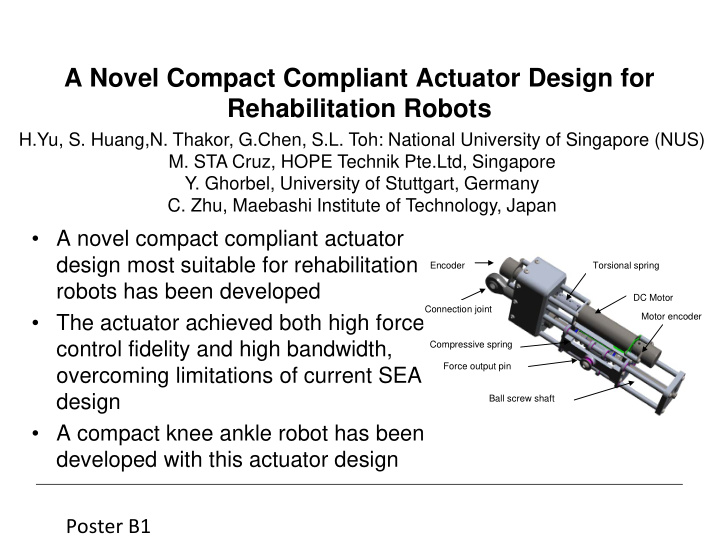



A Novel Compact Compliant Actuator Design for Rehabilitation Robots H.Yu, S. Huang,N. Thakor, G.Chen, S.L. Toh: National University of Singapore (NUS) M. STA Cruz, HOPE Technik Pte.Ltd, Singapore Y. Ghorbel, University of Stuttgart, Germany C. Zhu, Maebashi Institute of Technology, Japan • A novel compact compliant actuator design most suitable for rehabilitation Encoder Torsional spring robots has been developed DC Motor Connection joint Motor encoder • The actuator achieved both high force control fidelity and high bandwidth, Compressive spring Force output pin overcoming limitations of current SEA design Ball screw shaft • A compact knee ankle robot has been developed with this actuator design Poster B1
Poster B2
Poster B3
Development and Control of a Lower Extremity Assistive Device (LEAD) for Gait Rehabilitation Poster B4
Non-Contact Capacitance Sensing for Continuous Locomotion Mode Recognition: Design Specifications and Experiments with An Amputee Enhao Zheng, Long Wang, Yimin Luo, Kunlin Wei and Qining Wang Intelligent Control Laboratory, College of Engineering, Peking University, China qiningwang@pku.edu.cn • This paper presents a non-contact capacitance sensing system (C-Sens) to measure the interfacial signals between the residual limb and the prosthetic socket. • With the continuous phase dependent classification method and the quadratic discriminant analysis (QDA) classifier, the average recognition accuracies are 93.8% and 95.0% for the stance phase and the swing phase respectively. • The results show the potential of the proposed system for the control of powered lower-limb prostheses. Poster B5
Muscle Force Estimation Method with Surface EMG for a Lower Extremities Rehabilitation Device Poster B6
A Quasi-Passive Compliant Stance Control Knee-Ankle-Foot Orthosis Poster B7
Poster B8
Poster B9
Poster B10
A Novel Body Weight Support System Extension: Initial Concept and Simulation Study Poster B11
Poster B12
Poster B13 Poster B13
Towards ¡Extended ¡Virtual ¡Presence ¡of ¡ the ¡Therapist ¡in ¡Stroke ¡Rehabilita;on ¡ • The ¡concept ¡of ¡‘extended ¡virtual ¡presence’ ¡is ¡ proposed ¡to ¡extend ¡the ¡therapists’ ¡service ¡to ¡ remotely ¡located ¡pa;ents. ¡ • A ¡single ¡subject ¡case ¡study ¡is ¡performed ¡to ¡study ¡ the ¡feasibility ¡of ¡the ¡concept. ¡ • Results ¡indicate ¡that ¡the ¡therapist ¡is ¡able ¡to ¡gain ¡ sufficient ¡proficiency ¡in ¡teleopera;ng ¡a ¡robot, ¡ prescribing ¡well-‑balanced ¡and ¡challenging ¡tasks/ targets, ¡which ¡is ¡well ¡accepted ¡by ¡the ¡pa;ent ¡and ¡ the ¡spouse. ¡ Poster B14
Poster B15
Poster B16
Poster B17
A feasibility study of the effect of multichannel electrical stimulation and gravity compensation on hand function in stroke patients: a pilot study T. Krabben, MSc; J.H. Buurke, PhD; G.B. Prange, PhD; J.S Rietman, PhD, MD • A new therapeutic device for post stroke arm/hand training is being developed. • Effect of gravity compensation (GC) and electrical stimulation (ES) on dexterity was evaluated with Box and Blocks Test. • Possible to induce sufficient hand opening but no instantaneous improvement of dexterity due to GC and ES. • More specific and sophisticated control algorithms are needed. Poster B18
Poster B19
Poster B20
Design of a self-aligning 3-DOF actuated exoskeleton for diagnosis and training of wrist and forearm after stroke J. Houdijn Beekhuis*, Ard J. Westerveld*, Herman van der Kooij*†, and Arno H.A. Stienen*‡ *Laboratory of Biomechanical Engineering, University of Twente, Enschede, NL †Biomechanical Engineering, TU Delft, NL ‡Physical Therapy and Human Movement Sciences, Northwestern University, Chicago (IL), USA Corresponding author: arnostienen@gmail.com • A novel exoskeleton for wrist and forearm to help post- stroke survivors recover hand function has been developed • Decoupling of rotations and translations makes the device self-aligning to the wrist’s axes • The device can provide training and diagnostics in the full ROM of Flexion/Extension, Radial/Ulnar-deviation and Pronation/Supination while hand and fingers remain free • CAD design has been completed and a prototype will provide real-world validation of mechanical and functional properties Poster B21
Poster B22
Poster B23
Poster B24
Whole-arm Tactile Sensing for Beneficial and Acceptable Contact During Robotic Assistance Phillip M. Grice 1 , Marc D. Killpack 1 , Advait Jain 2 , Sarvagya Vaish 1 , Jeffrey Hawke 1 , Charles C. Kemp 1 1. Healthcare Robotics Lab, Georgia Institute of Technology 2. Redwood Robotics • Avoiding contact through safety margins significantly reduces the reachable workspace of an assistive robot. • Whole-arm tactile sensing can improve task performance and limit contact forces during assistive tasks. • Able-bodied users controlling an assistive robot to perform a task around their bodies find physical contact by the robot acceptable. Poster B25
Poster B26
Design of a Robotic Mobility System to Promote Socialization in Children Xi Chen, Christina Ragonesi, James C. Galloway, University of Delaware, USA Sunil K. Agrawal, Columbia University, USA • A robotic mobility system has been developed to track multiple moving targets and plan a path to the goal while avoiding moving obstacles. • Use force-feedback to train children to join the peers in a ball chasing game. • Results show that all modules functioned well and the system is promising in promoting socialization in children. Poster B27
A Haptically Enhanced Painting as a Tool for Neurorehabilitation HH Le, RCV Loureiro, A Zivanovic, MJ Loomes: Middlesex University, UK F Dussopt: Florian Dussopt Design Studio, UK N Phillips : Nick Phillips Design Studio, UK • A new form of interaction combining haptic and sonic exploration with static visual information from a real painting • Preliminary results suggest approach might be of value to neurorehabilitation by exploring concepts of augmented art works with technology (haptics + sound), promoting social integration and potential use in public spaces. Poster B28
Recommend
More recommend